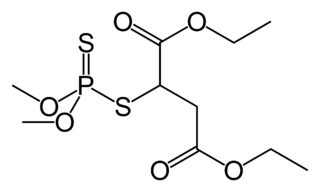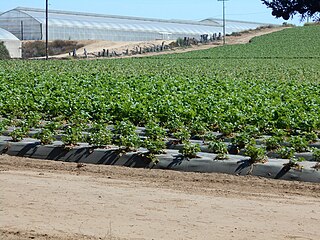
Pesticides are substances that are used to control pests. They include herbicides, insecticides, nematicides, fungicides, and many others. The most common of these are herbicides, which account for approximately 50% of all pesticide use globally. Most pesticides are used as plant protection products, which in general protect plants from weeds, fungi, or insects. In general, a pesticide is a chemical or biological agent that deters, incapacitates, kills, or otherwise discourages pests. Target pests can include insects, plant pathogens, weeds, molluscs, birds, mammals, fish, nematodes (roundworms), and microbes that destroy property, cause nuisance, or spread disease, or are disease vectors. Along with these benefits, pesticides also have drawbacks, such as potential toxicity to humans and other species.

In organic chemistry, isocyanate is the functional group with the formula R−N=C=O. Organic compounds that contain an isocyanate group are referred to as isocyanates. An organic compound with two isocyanate groups is known as a diisocyanate. Diisocyanates are manufactured for the production of polyurethanes, a class of polymers.
Bromomethane, commonly known as methyl bromide, is an organobromine compound with formula CH3Br. This colorless, odorless, nonflammable gas is produced both industrially and biologically. It is a recognized ozone-depleting chemical. It was used extensively as a pesticide until being phased out by most countries in the early 2000s. From the chemistry perspective, it is one of the halomethanes.
Chlordane, or chlordan, is an organochlorine compound that was used as a pesticide. It is a white solid. In the United States, chlordane was used for termite-treatment of approximately 30 million homes until it was banned in 1988. Chlordane was banned 10 years earlier for food crops like corn and citrus, and on lawns and domestic gardens.

Malathion is an organophosphate insecticide which acts as an acetylcholinesterase inhibitor. In the USSR, it was known as carbophos, in New Zealand and Australia as maldison and in South Africa as mercaptothion.

Fumigation is a method of pest control or the removal of harmful microorganisms by completely filling an area with gaseous pesticides, or fumigants, to suffocate or poison the pests within. It is used to control pests in buildings, soil, grain, and produce. Fumigation is also used during the processing of goods for import or export to prevent the transfer of exotic organisms.

Sulfuryl fluoride (also spelled sulphuryl fluoride) is an inorganic compound with the formula SO2F2. It is an easily condensed gas and has properties more similar to sulfur hexafluoride than sulfuryl chloride, being resistant to hydrolysis even up to 150 °C. It is neurotoxic and a potent greenhouse gas, but is widely used as a fumigant insecticide to control termites.

Ethylbenzene is an organic compound with the formula C6H5CH2CH3. It is a highly flammable, colorless liquid with an odor similar to that of gasoline. This monocyclic aromatic hydrocarbon is important in the petrochemical industry as a reaction intermediate in the production of styrene, the precursor to polystyrene, a common plastic material. In 2012, more than 99% of ethylbenzene produced was consumed in the production of styrene.

Heptachlor is an organochlorine compound that was used as an insecticide. Usually sold as a white or tan powder, heptachlor is one of the cyclodiene insecticides. In 1962, Rachel Carson's Silent Spring questioned the safety of heptachlor and other chlorinated insecticides. Due to its highly stable structure, heptachlor can persist in the environment for decades. In the United States, the Environmental Protection Agency has limited the sale of heptachlor products to the specific application of fire ant control in underground transformers. The amount that can be present in different foods is regulated.
Iodomethane, also called methyl iodide, and commonly abbreviated "MeI", is the chemical compound with the formula CH3I. It is a dense, colorless, volatile liquid. In terms of chemical structure, it is related to methane by replacement of one hydrogen atom by an atom of iodine. It is naturally emitted by rice plantations in small amounts. It is also produced in vast quantities estimated to be greater than 214,000 tons annually by algae and kelp in the world's temperate oceans, and in lesser amounts on land by terrestrial fungi and bacteria. It is used in organic synthesis as a source of methyl groups.

Endrin is an organochlorine compound with the chemical formula C12H8Cl6O that was first produced in 1950 by Shell and Velsicol Chemical Corporation. It was primarily used as an insecticide, as well as a rodenticide and piscicide. It is a colourless, odorless solid, although commercial samples are often off-white. Endrin was manufactured as an emulsifiable solution known commercially as Endrex. The compound became infamous as a persistent organic pollutant and for this reason it is banned in many countries.

Methoxychlor is a synthetic organochloride insecticide, now obsolete. Tradenames for methoxychlor include Chemform, Maralate, Methoxo, Methoxcide, Metox, and Moxie.

1,2-Dibromo-3-chloropropane (dibromochloropropane), better known as DBCP, is the organic compound with the formula BrCH(CH2Br)(CH2Cl). It is a dense colorless liquid although commercial samples often appear amber or even brown. It is the active ingredient in the nematicide Nemagon, also known as Fumazone.
Right to know is a human right enshrined in law in several countries. UNESCO defines it as the right for people to "participate in an informed way in decisions that affect them, while also holding governments and others accountable". It pursues universal access to information as essential foundation of inclusive knowledge societies. It is often defined in the context of the right for people to know about their potential exposure to environmental conditions or substances that may cause illness or injury, but it can also refer more generally to freedom of information or informed consent.

Bromacil is an organic compound with the chemical formula C9H13BrN2O2, commercially available as a herbicide. Bromacil was first registered as a pesticide in the U.S. in 1961. It is used for brush control on non-cropland areas. It works by interfering with photosynthesis by entering the plant through the root zone and moving throughout the plant. Bromacil is one of a group of compounds called substituted uracils. These materials are broad spectrum herbicides used for nonselective weed and brush control on non-croplands, as well as for selective weed control on a limited number of crops, such as citrus fruit and pineapple. Bromacil is also found to be excellent at controlling perennial grasses.

The California Department of Pesticide Regulation, also known as DPR or CDPR, is one of six boards and departments of the California Environmental Protection Agency (Cal/EPA).

Naled (Dibrom) is an organophosphate insecticide. Its chemical name is dimethyl 1,2-dibromo-2,2-dichloroethylphosphate.

1,2,3-Trichloropropane (TCP) is an organic compound with the formula CHCl(CH2Cl)2. It is a colorless liquid that is used as a solvent and in other specialty applications.

Sulfotep (also known as tetraethyldithiopyrophosphate and TEDP) is a pesticide commonly used in greenhouses as a fumigant. The substance is also known as Dithione, Dithiophos, and many other names. Sulfotep has the molecular formula C8H20O5P2S2 and belongs to the organophosphate class of chemicals. It has a cholinergic effect, involving depression of the cholinesterase activity of the peripheral and central nervous system of insects. The transduction of signals is disturbed at the synapses that make use of acetylcholine. Sulfotep is a mobile oil that is pale yellow-colored and smells like garlic. It is primarily used as an insecticide.

Angelita C. et al. v. California Department of Pesticide Regulation is an Administrative complaint filed in June 1999 with the US Environmental Protection Agency about disproportionate harm to Latino children from toxic pesticides used near schools. It said that the California Department of Pesticide Regulation (CDPR) had caused discriminatory harm to Latino children when it renewed the registration for methyl bromide in January 1999 without considering the effect on nearby schools, in some cases adjacent to the fields.























